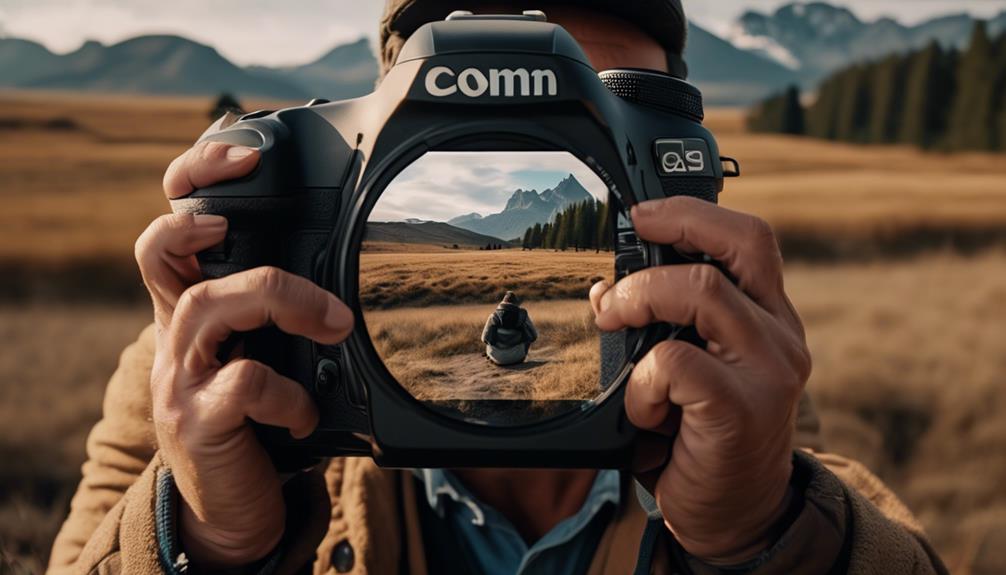Please note this post may contain affiliate links picked by me (Jay) that I have deemed may be of interest or relevant to you the reader of this.
These links do not affect the cost of the thing if you decide to purchase but i may get a little money if you choose to purchase.
For more information on my affiliate link policy click here.
Have you ever wondered what sets apart a stunning photograph from a merely average one?
Well, I'm here to tell you that it's all about the art of composition. The way elements are arranged within a frame can make or break a photo, transforming it from mundane to extraordinary.
But how exactly can we enhance our photos through composition? In this discussion, we will explore some key techniques, such as the rule of thirds, leading lines, framing the subject, balancing elements, and utilizing symmetry and patterns.
These tried-and-true methods will help you take your photography to the next level, capturing images that are visually captivating and emotionally resonant.
So, let's dive into the world of composition and unlock the secrets to creating truly remarkable photographs.
Key Takeaways
- Rule of Thirds: The rule of thirds is a fundamental principle of composition that divides the frame into a grid of nine equal parts. It helps determine the placement of the focal point and adds interest and depth to photos.
- Leading Lines: Leading lines are a powerful composition technique that guides the viewer's eye through the image and creates perspective and depth. They can be found in various forms and incorporate visual flow to enhance compositions.
- Framing and Depth: Framing the subject with foreground and background elements enhances composition by adding depth and dimension. It also considers centering and utilizes symmetry and patterns to create visually striking compositions.
- Balancing Elements: Balancing elements involves the placement and distribution of elements within the frame. Lighting, color palette, and the harmonious combination of colors contribute to balance. Experimenting with different lighting techniques can further enhance composition.
Rule of Thirds
The Rule of Thirds is a fundamental principle that can greatly enhance the composition of your photos. It's a simple yet powerful technique that helps create visually appealing and balanced images. The concept is based on the golden ratio, which is a mathematical ratio that has been used in art and design for centuries.
By dividing the frame into a grid of nine equal parts, with two horizontal and two vertical lines intersecting, you can determine where to place your focal point. This technique adds interest and depth to your photos by avoiding the temptation to place the subject dead center. Instead, the focal point should be placed along one of the gridlines or at one of the intersections. This creates a sense of balance and allows the viewer's eyes to move naturally through the image.
The Rule of Thirds also helps create a dynamic composition by incorporating negative space. Negative space refers to the empty areas surrounding the subject. By positioning your subject off-center, you can use the negative space to draw attention to the focal point and create a more engaging composition.
Incorporating the Rule of Thirds into your photography can significantly improve the overall impact of your images. It's a simple yet highly effective technique that adds visual interest, balance, and depth to your photos. So, the next time you're out capturing moments with your camera, remember to use the Rule of Thirds and watch your compositions come to life.
Leading Lines
When it comes to creating captivating and dynamic compositions in photography, one technique that can greatly enhance your images is the use of leading lines. Leading lines are powerful visual elements that guide the viewer's eye through a photograph, creating a sense of perspective and depth. They can be found in various forms, such as roads, fences, buildings, or even natural elements like rivers or tree branches. By strategically incorporating leading lines into your composition, you can create a visual flow that adds interest and draws the viewer deeper into the image.
To understand the impact of leading lines, let's take a look at the following table:
| Leading Line Type | Description | Example |
|---|---|---|
| Diagonal | Diagonal lines create a sense of movement and dynamic energy. They can be used to lead the viewer's eye from one corner of the frame to another. | A road cutting through a landscape. |
| Horizontal | Horizontal lines convey a sense of stability and tranquility. They can be used to guide the viewer's gaze from one side of the frame to another. | The horizon line in a seascape photograph. |
| Vertical | Vertical lines evoke a feeling of strength and grandeur. They can be used to direct the viewer's attention upwards or downwards within the frame. | A tall building towering over a cityscape. |
Framing the Subject
One effective way to enhance the composition of your photos is by framing the subject. By strategically using the foreground and background elements, you can create a captivating image that draws the viewer's attention directly to the subject. This technique not only adds depth and dimension to your photos but also allows you to express your creativity and showcase your unique perspective.
When framing the subject, one key aspect to consider is the foreground and background elements. The foreground can act as a frame that surrounds and highlights the subject, while the background can provide context and add visual interest. By carefully selecting these elements, you can create a composition that's visually appealing and visually tells a story.
Another important factor to keep in mind when framing the subject is centering. While centering the subject is a common approach, it isn't the only option. Experimenting with different placements can lead to more dynamic and engaging compositions. For example, placing the subject slightly off-center can create a sense of movement or add visual tension to the image.
Framing the subject is a versatile technique that can be used across different genres of photography. Whether you're capturing landscapes, portraits, or still life, incorporating foreground and background elements can elevate the overall composition. It allows you to guide the viewer's eye and create a visual narrative that goes beyond a simple snapshot.
Balancing Elements
To create visually balanced compositions, it's essential to carefully consider the placement and distribution of elements within the frame. Balancing elements in a photograph is like conducting a symphony, where each instrument plays its part to create a harmonious melody. Just like a conductor, we photographers have the power to orchestrate our images by using lighting techniques and a well-chosen color palette.
When it comes to balancing elements, lighting plays a crucial role. By understanding how light interacts with our subjects, we can create depth and dimension in our compositions. Experimenting with different lighting techniques, such as backlighting or side lighting, can add drama and visual interest to our photos. The interplay between light and shadow can create a dynamic balance that draws the viewer's eye to the focal point of the image.
In addition to lighting, the color palette of a photograph can also contribute to its overall balance. Colors have the power to evoke emotions and create visual harmony. By carefully choosing a color scheme that complements the subject and the mood we want to convey, we can enhance the balance and impact of our compositions. Whether we opt for a monochromatic palette or a contrasting color scheme, it's important to ensure that the colors work together harmoniously to create a visually pleasing image.
Symmetry and Patterns
Symmetry and patterns in photography have the power to captivate viewers and create visually striking compositions. When applied effectively, they can transform an ordinary photograph into a work of art that grabs attention and evokes emotions. By incorporating geometric shapes and utilizing repetition and rhythm, photographers can create images that are both innovative and visually appealing.
Here are some ways in which symmetry and patterns can enhance your photographs:
- Geometric Shapes: Introducing geometric shapes into your composition can add a sense of order and structure. Whether it's the symmetry of a square or the curves of a circle, these shapes can create a visually pleasing balance that draws the viewer's eye.
- Repetition: Repetition is a powerful tool that can create a sense of harmony and continuity in your images. By repeating elements such as lines, shapes, or colors, you can establish a visual rhythm that guides the viewer's gaze throughout the photograph.
- Rhythm: Just like in music, rhythm in photography refers to the visual flow and movement within an image. By strategically placing elements and creating patterns, you can establish a sense of rhythm that adds energy and interest to your composition.
- Visual Impact: Symmetry and patterns can create a strong visual impact that immediately grabs the viewer's attention. Whether it's the intricate patterns of a kaleidoscope or the perfect symmetry of a reflection, these elements can create a sense of awe and wonder.
Frequently Asked Questions
How Can I Create a Sense of Depth in My Photos?
To create a sense of depth in my photos, I focus on capturing the layers and dimensions of the landscape.
By using elements like leading lines, foreground objects, and perspective, I can make the viewer feel like they're stepping into the photo.
Additionally, incorporating motion in photos adds a dynamic element that enhances the sense of depth.
Whether it's capturing the movement of water or the blur of a passing car, it brings the scene to life and creates a more immersive experience.
What Are Some Common Mistakes to Avoid When Using the Rule of Thirds?
When using the rule of thirds, it's important to be mindful of some common mistakes to avoid.
One mistake is a lack of balance in your composition. Make sure to evenly distribute your main subjects across the frame for a visually pleasing result.
Another mistake is ignoring the background. Remember to pay attention to what's happening behind your subject to avoid any distracting elements.
How Can I Effectively Use Diagonals as Leading Lines in My Composition?
Using leading lines effectively is a powerful way to create depth in your composition.
Diagonals, in particular, can add a dynamic and energetic feel to your photos.
By positioning your subject along a diagonal line, you can guide the viewer's eye through the image, creating a sense of movement and direction.
Experiment with different angles and perspectives to find the most impactful diagonals.
Don't be afraid to think outside the box and push the boundaries of traditional composition.
Are There Any Specific Techniques for Framing a Subject in a Way That Adds Interest to the Photo?
Framing a subject in a way that adds interest to the photo involves incorporating foreground and background elements. By carefully selecting what appears in the foreground and background, you can create depth and give your subject a sense of place.
Additionally, negative space plays a crucial role in composition. Empty areas in your photo can be used to create visual interest and draw attention to your subject.
Experimenting with these techniques can result in innovative and captivating photographs.
What Are Some Creative Ways to Introduce Asymmetry in My Composition While Still Maintaining Balance?
When it comes to introducing asymmetry in composition while still maintaining balance, there are some seriously cool techniques to explore.
One way is to play with color contrast, using bold and vibrant hues to create visual interest.
Another trick is to utilize negative space, strategically leaving areas empty to balance out the asymmetrical elements.
These techniques can add a dynamic and innovative touch to your compositions, making your photos stand out from the crowd.
Conclusion
In conclusion, mastering the art of composition is the key to enhancing your photos and capturing the attention of your audience. By applying the Rule of Thirds, utilizing leading lines, framing your subject, balancing elements, and incorporating symmetry and patterns, you can create visually stunning images that tell a story.
So, grab your camera, experiment with these techniques, and watch as your photos come to life with a new level of creativity and impact. Get ready to see your photography skills soar!


